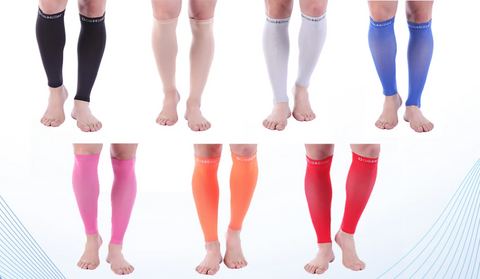How to Deal with Varicose Veins with Compression Sleeves & Socks
If you’ve heard that compression socks prevent varicose veins, you’re probably wondering if it’s actually true or just another wellness trend. They can help, especially if you’re someone who sits or stands for long periods, has circulation issues, or is starting to notice early vein changes. This guide breaks down how they work, what type you need, and which features matter most.

Do Compression Socks Really Prevent Varicose Veins?
Yes, compression socks can help prevent varicose veins, especially when used consistently and correctly. Compression socks improve blood flow in your legs, reducing pooling and pressure inside your veins. This helps prevent existing vein issues from getting worse and lowers the risk of new varicose veins forming.
They’re recommended for:
-
People who sit or stand all day
-
Pregnant women
-
Athletes
-
People with a family history of venous insufficiency
-
Frequent travelers (especially long flights)
While they don’t cure varicose veins, they support better circulation and slow down progression.
How Do Compression Socks Prevent Varicose Veins?
The physiology behind it is simple and effective:
Compression socks apply graduated pressure, tightest at the ankle and looser as they go up the leg.
This pressure pattern helps:
-
Push blood upward toward the heart
-
Prevent blood from pooling in the veins
-
Reduce swelling and inflammation
-
Support weakened vein walls and valves
-
Improve oxygen delivery to tissues
So when people ask, “how do compression socks prevent varicose veins?”, the answer is: by helping your veins do their job more efficiently.
What Level of Compression Is Best to Prevent Varicose Veins?
Choosing the right pressure level matters for both comfort and effectiveness:
| Compression Level | Best For | Notes |
|---|---|---|
| 8–15 mmHg | Light support | Good for daily wear, light swelling |
| 15–20 mmHg | Mild varicose vein prevention | Ideal for long hours of sitting/standing |
| 20–30 mmHg | Moderate prevention, medical use | Best for people with visible veins, pregnancy swelling, or frequent pain |
| 30–40 mmHg | Severe cases (doctor recommended) | Not for beginners; medical supervision advised |
For most people looking to prevent varicose veins, 15–20 mmHg or 20–30 mmHg works best.
Best Compression Socks for Varicose Vein Prevention
When searching for the best compression socks for varicose vein prevention, look for reliable brands known for consistent pressure, durability, and comfort.
One trusted brand worth highlighting is Doc Miller Sports, known for high-quality medical-grade compression products.
Worth Considering Compression Socks for Varicose Vein
-
Premium Calf Compression Sleeves (20–30 mmHg)
Great for athletes, runners, and people who prefer open-foot designs. -
Compression Socks for Men & Women (20–30 mmHg)
Ideal for daily varicose vein prevention, long work shifts, or travel. -
Open Toe Compression Socks
Perfect for people who want toe flexibility or have toe discomfort.
Key Features to Look For
Before buying, check for:
-
Graduated compression
-
Breathable, moisture-wicking fabric
-
Durable stitching
-
Comfortable band that doesn’t roll down
-
True medical-grade pressure
-
Range of sizes for accurate fit
Recommended Types of Compression Socks
Different styles suit different needs:
-
Knee-high compression socks: Most recommended for varicose vein prevention
-
Thigh-high compression stockings: Helpful for swelling above the knee
-
Open toe compression socks: Good for warmer climates or sensitive toes
-
Compression sleeves: Best for sports, though not ideal for full varicose vein support
How to Choose the Right Compression Socks for Your Needs
1. Sizing Guide: Why Fit Matters
A common mistake is choosing socks by shoe size, compression socks must fit your leg dimensions, not your foot size.
A bad fit can mean:
-
Not enough pressure
-
Too much pressure
-
Rolling bands
-
Discomfort or numbness
2. How to Measure Your Calf and Ankle
For accurate sizing:
-
Ankle circumference: Measure just above the ankle bone
-
Calf circumference: Measure the widest part of your calf
-
Calf length: Measure from heel to knee crease
Always compare your measurements with the brand’s size chart.
3. Style Options: Closed Toe vs. Open Toe
-
Closed Toe: Best for full-day wear, work, and travel
-
Open Toe: Great for people with toe discomfort, bunions, or warm climates
Frequently Asked Questions
1. Can compression socks stop new varicose veins from developing?
They can help reduce the risk, especially if worn regularly. They support healthier circulation and decrease vein pressure, two major contributors to varicose veins.
2. Are compression socks safe during pregnancy?
Yes. In fact, they’re often recommended to reduce swelling, heaviness, and early varicose veins during pregnancy.
For moderate compression (20–30 mmHg), consult your OB-GYN first.
3. Do athletes wear them to prevent venous issues?
Yes. Many athletes wear compression socks for muscle support and reduce swelling after training. Doc Miller Sports are especially popular among runners, cyclists, and gym-goers.
Disclaimer: This article should not be construed as medical advice. Please contact a licensed physician for proper diagnosis of your specific case.

